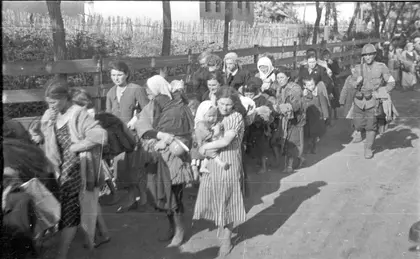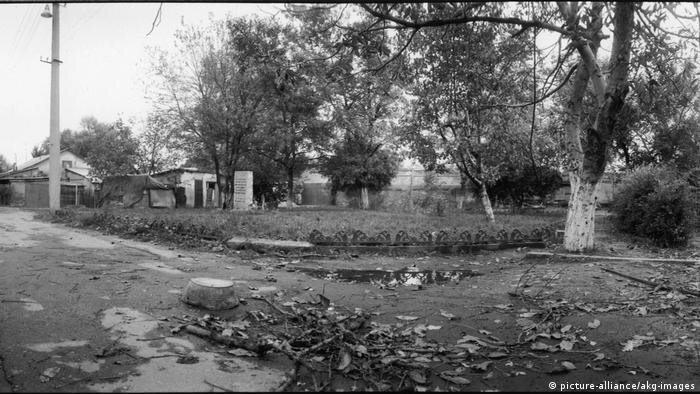From the Editors
The UN has designated Jan. 27 — the anniversary of the liberation of Auschwitz-Birkenau — as International Holocaust Remembrance Day.
JOIN US ON TELEGRAM
Follow our coverage of the war on the @Kyivpost_official.
On this annual day of commemoration, we honor the six million Jewish victims of the Holocaust and millions of other victims of Nazism. The Kyiv Post is doing so by recalling what terrible form and scale the Holocaust took in Odesa, occupied by Nazi Germany’s Romanian ally.
From 1941 to 1945, around 130,000 Jews were tortured and killed in the Odesa region. The biggest massacre, of 30,000 people in one day, mostly Jews, occurred on October 23, 1941. The Odesa tragedy has been a long overlooked page of Shoah history, until now.
The 1941 Odesa massacre
October 16, 1941. Following two and a half months of bitter fighting, the Soviet Red Army surrendered Odesa. Romanian troops backed by the German Wehrmacht marched into the city. Odesa’s capture was a major strategic victory. Some 250,000 inhabitants, including more than 90,000 Jews, remained after the exodus of Soviet soldiers and civilians.
The trigger of the terrible massacre at the beginning of the occupation was an explosion in the former building of the NKVD, which was located in today’s Marazlievskaya Street (in those years named after Engels). In the second half of October, the building hosted the headquarters of the Romanian Military’s 10th Infantry Division.
October 22, 1941, 6:45 pm. A radio-controlled mine, which was laid in the building in advance by sappers of the Red Army before the surrender of the city, blew up. As a result of the explosion, the building partially collapsed and 67 occupants were killed, including 16 Romanian officers, the Romanian commander of the city General Ioan Glogojeanu, and 4 Germans. Responsibility for this successful Soviet Army operation was blamed on local Jews and Communists. A similar ploy had been used by the Nazis a month earlier – the blowing up Kyiv’s main street, Khreshchatyk – to justify the round up of thousands of Jews and their execution at Babyn Yar.
The Axis soldiers reacted with rage and decided on retaliation measures: for every dead officer, 200 “Bolsheviks” had to be executed. For every soldier, 100. But, there were no more Bolsheviks in the occupied city and very few adult men in general, apart from some 3,000 prisoners of war. Most of Odesa’s males had long ago joined either the army or the partisans. Jewish citizens became the obvious victims of the revenge.
October 23, 1941. Actions to exterminate approx. 10,000 hostages, many of whom Jews, were implemented. All along Engels Street, the Romanian soldiers broke into the apartments of Odesa residents, shooting and hanging all the residents they found, without exception. There were also raids on the streets, markets of the city and in the suburbs. Even civilians who did not know anything about the terrorist attack were executed on the spot, shot at against the walls of houses or fences.
According to historians, about a hundred men were caught and shot at the Bolshoy Fountain, about two hundred people were hanged in Slobodka near the market, and 251 inhabitants were executed at Moldavanka district. Eyewitnesses of those events observed a horrible sight on the Aleksandrovsky Prospekt: about four hundred citizens were hanged here.
People who did not suffer a similar fate were herded into columns and led to the Lustdorf road to a territory, where there were nine empty artillery depots of the Red Army. Here the bloodiest crime on the territory of Odesa took place. Since it was difficult to shoot all of them, they just got people into them. Then, the warehouses were doused in gasoline and set on fire.
And these warehouses were burning. According to the acts of the commission, until November 10, everything continued to burn. Witnesses say that there was such a smell of human meat that it was impossible to be in the district. This was the first Babi Yar in Odesa.
- Pavel Kozlenko. Director of the Odesa Holocaust Museum.
According to Pavlol Kozlenko of the Odesa Holocaust Museum, a special committee investigated the massacre site after the war, measuring the ground and its contents: "The number of victims could be calculated by determining the proportion of bone remains found in the ashes."
The mass murder continues
The mass murder in Odesa did not stop during the occupation. The director explained: “our region did not have gas chambers like Auschwitz, so people were forced to walk even 200 kilometers in freezing weather, towards the Bogdanovka camp. People died of hunger, disease, or shot to death. So, another 56,000 Jews disappeared from December 1941 to April 1942”.
In 1939, before the war, approximately 30 percent of Odesa’s 600,000 residents were Jewish. The Black Sea port city served as an important centre for European Jewry and Zionist activism. According to the Yad Vashem Holocaust museum in Jerusalem,
at least 90,000 Odesan Jews died in the Holocaust at the hands of the Nazis and their Romanian allies.
At the end of the conflict, between exodus and massacres, in the urban area "only 600 survived", reported Kozlenko. "Everything is fastidiously documented.”
The number of Jews killed during the war in the Odesa region amounts to 130.000. Volunteers and historians have identified over 1,500 execution sites. Most of them outside the city or towns. Victims were typically buried without any grave markers, which makes an accurate calculation difficult. Just as a term of comparison, in the well-known Babi Yar near Kyiv the Jews murdered were almost 34.000.
Memory of the Holocaust in Ukraine
The memory of that holocaust is kept in a small, volunteer-run museum in Odesa, which is funded by private donations from the city and from abroad, like a generous Baltimore Jewish association. No support comes from Ukrainian State institutions. "Ukraine still doesn't see the Holocaust as part of its own history, or as a tragedy of Ukrainian citizens," Kozlenko claims despite the official commemorations of the Babyn Yar tragedy each year in Kyiv.
He believes that Ukraine lacks an official culture of remembrance of the Holocaust. There is no State museum memorializing the over 1.5 million Jewish victims. No one officially takes care of the many memorials erected by survivors after the end of the war. For places like Auschwitz, Dachau or Mauthausen there are upsetting memorials with personal belongings of the victims; for the massacre of Odesa, there is only a small commemorative plaque at a crossroad.
“Shoah by bullets”
The American historian Timothy Snyder, an expert in the history of the Shoah, pointed out how the Holocaust has become synonymous in the public perception with the large-scale killing that took place in places like Auschwitz that served as both concentration and extermination camps. In comparison, the "Shoah by bullets," as Snyder names the mass shooting executions undertaken by SS and police battalions in numerous eastern European villages, remains a blank spot in Holocaust remembrance, either in western or in eastern Europe. Unlike the concentration camps, hardly anyone survived the mass shootings, meaning no one was able to pass along the story.
Moreover, people tend to think only of Germans as responsible for the massacres of Jews, whilst in Ukraine they recruited for the shootings Ukrainian volunteers, usually rewarded with free beer and tins of food. This is illustated in the Odesa Holocaust Museum.
Soviet propaganda also played a role. "In the Soviet era, the historical memory landscape was destroyed," Kozlenko said. "Jews hadn't been murdered; Soviet citizens had been." The great-grandfather of Pavlo Kozlenko was burned to death in the munitions depot near Odesa, in October 1941, "not as a Soviet citizen, but because he was Jewish."
You can also highlight the text and press Ctrl + Enter




